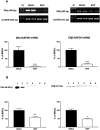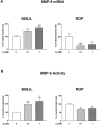Estrogen-related abnormalities in glomerulosclerosis-prone mice: reduced mesangial cell estrogen receptor expression and prosclerotic response to estrogens
- PMID: 12000739
- PMCID: PMC1850880
- DOI: 10.1016/S0002-9440(10)61134-0
Estrogen-related abnormalities in glomerulosclerosis-prone mice: reduced mesangial cell estrogen receptor expression and prosclerotic response to estrogens
Abstract
The development and progression of glomerulosclerosis (GS) is determined by the genetic background. The incidence of end-stage renal disease is increased in postmenopausal women, suggesting that estrogen deficiency may play a role in the accumulation of extracellular matrix by mesangial cells (MCs), which are primarily responsible for the synthesis and degradation of this matrix. Using mouse models that are prone or resistant to the development of GS, we compared the expression of estrogen receptor (ER)-alpha and ER-beta subtypes in GS-prone and GS-resistant glomeruli and isolated MCs, and examined the effects of estrogens on ER, collagen, and matrix metalloproteinase (MMP) expression in MCs. Glomeruli and MCs from GS-prone mice had decreased expression of ER-alpha and ER-beta subtypes and ER transcriptional activity was also decreased in their MCs. Importantly, although 17 beta-estradiol treatment resulted in decreased collagen accumulation and increased MMP-9 expression and activity in MCs from GS-resistant mice, there was, paradoxically, no effect on collagen accumulation and decreased MMP-9 expression and activity in MCs from GS-prone mice. Thus, GS susceptibility is associated with diminished ER expression in MCs. The renal protective effects of estrogens, including decreased collagen accumulation and increased MMP-9 expression, seem to be blunted in GS-prone MCs.
Figures






Similar articles
-
Autocrine activation of the local insulin-like growth factor I system is up-regulated by estrogen receptor (ER)-independent estrogen actions and accounts for decreased ER expression in type 2 diabetic mesangial cells.Endocrinology. 2005 Feb;146(2):889-900. doi: 10.1210/en.2004-1121. Epub 2004 Nov 18. Endocrinology. 2005. PMID: 15550505
-
Expression and regulation of estrogen receptors in mesangial cells: influence on matrix metalloproteinase-9.J Am Soc Nephrol. 2001 Feb;12(2):241-251. doi: 10.1681/ASN.V122241. J Am Soc Nephrol. 2001. PMID: 11158214
-
Gender-specific effects of endogenous testosterone: female alpha-estrogen receptor-deficient C57Bl/6J mice develop glomerulosclerosis.Kidney Int. 2007 Aug;72(4):464-72. doi: 10.1038/sj.ki.5002328. Epub 2007 May 9. Kidney Int. 2007. PMID: 17495854
-
Estrogen and the brain: beyond ER-alpha, ER-beta, and 17beta-estradiol.Ann N Y Acad Sci. 2005 Jun;1052:136-44. doi: 10.1196/annals.1347.009. Ann N Y Acad Sci. 2005. PMID: 16024756 Review.
-
[Glomerular extracellular matrix in glomerulosclerosis by molecular biology].Nihon Rinsho. 1992 Dec;50(12):3038-45. Nihon Rinsho. 1992. PMID: 1491457 Review. Japanese.
Cited by
-
Inhibition of Advanced Glycation End Products (AGEs) Accumulation by Pyridoxamine Modulates Glomerular and Mesangial Cell Estrogen Receptor α Expression in Aged Female Mice.PLoS One. 2016 Jul 18;11(7):e0159666. doi: 10.1371/journal.pone.0159666. eCollection 2016. PLoS One. 2016. PMID: 27428057 Free PMC article.
-
Subtype specific estrogen receptor action protects against changes in MMP-2 activation in mouse retinal pigmented epithelial cells.Exp Eye Res. 2008 Apr;86(4):653-60. doi: 10.1016/j.exer.2008.01.010. Epub 2008 Jan 17. Exp Eye Res. 2008. PMID: 18313050 Free PMC article.
-
Nuclear receptors in renal disease.Biochim Biophys Acta. 2011 Aug;1812(8):1061-7. doi: 10.1016/j.bbadis.2011.04.003. Epub 2011 Apr 14. Biochim Biophys Acta. 2011. PMID: 21511032 Free PMC article. Review.
-
Autoimmune glomerulonephritis with spontaneous formation of splenic germinal centers in mice lacking the estrogen receptor alpha gene.Proc Natl Acad Sci U S A. 2004 Feb 10;101(6):1720-4. doi: 10.1073/pnas.0307915100. Epub 2004 Jan 26. Proc Natl Acad Sci U S A. 2004. PMID: 14745006 Free PMC article.
-
Renoprotective effects of a selective estrogen receptor modulator, raloxifene, in an animal model of diabetic nephropathy.Am J Nephrol. 2007;27(2):120-8. doi: 10.1159/000099837. Epub 2007 Feb 15. Am J Nephrol. 2007. PMID: 17308373 Free PMC article.
References
-
- He CJ, Esposito C, Phillips C, Zalups RK, Henderson DA, Striker GE, Striker LJ: Dissociation of glomerular hypertrophy, cell proliferation and glomerulosclerosis in mouse strains heterozygous for a mutation (Os) which induces a 50% reduction in nephron number. J Clin Invest 1996, 97:1-8 - PMC - PubMed
-
- Lenz O, Elliot SJ, Stetler-Stevenson WG: Matrix metalloproteinases in renal development and disease. J Am Soc Nephrol 2000, 11:575-581 - PubMed
-
- Nagase H: Activation mechanisms of matrix metalloproteinases. Biol Chem 1997, 378:151-160 - PubMed
-
- Zheng F, Striker G, Esposito C, Lupia E, Striker L: Strain differences rather than hyperglycemia determine the severity of glomerulosclerosis in mice. Kidney Int 1998, 54:1999-2007 - PubMed
-
- Lenz O, Zheng F, Vilar J, Doublier S, Lupia E, Schwedler S, Striker LJ, Striker GE: The inheritance of glomerulosclerosis in mice is controlled by multiple quantitative trait loci. Nephrol Dial Transplant 1998, 13:3074-3078 - PubMed
Publication types
MeSH terms
Substances
Grants and funding
LinkOut - more resources
Full Text Sources
Miscellaneous

